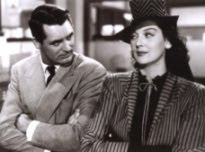The curious split-screen finale of "Viva Las Vegas"
In "My Lucky Life In and Out of Show Business: A Memoir" (Three Rivers Press), Dick Van Dyke reminisces about his debut movie, "Bye Bye Birdie" (1963), and director George Sidney's infatuation with Ann-Margret.
In one chapter, Van Dyke describes the moment when he and co-star Janet Leigh walked on to a sound stage to find Ann-Margret sitting on Sidney's lap. Both looked at each other and, in unison, said, "Uh-oh."
Later, after the first preview of the film, Leigh (who was supposed to be the star of the film and who had worked with Sidney on several films prior to "Birdie") walked up to Sidney and asked, "Where did that song come from?" She was referring to the new title song that (1) was never in the stage version, (2) apparently was filmed in secrecy and (3) shamelessly showcases A-M. There were other reports - althought not in Van Dyke's book - that Leigh then slapped Sidney across the face. She felt betrayed.
The film version of "Bye Bye Birdie" got off to a bumpy start. It was supposed to be directed by Gower Champion, who helmed it on Broadway. It was to be his first as a filmmaker. Champion hoped to cast Jack Lemmon and Debbie Reynolds in the leads. He had wanted Lemmon for the stage version - the two had co-starred years before in a Betty Grable musical, "Three for the Show" (1955) - but Lemmon was already committed to a straight play, "Face of a Hero," the same season.
And so the stage role went to Dick Van Dyke. Chita Rivera, of course, was his co-star on Broadway, playing the self-described "Spanish Rose." I've been critical of Ann-Margret's miscasting in the film - and I've no idea if that decision was made by Champion or Sidney - because she's supposed to be playing a character who is either 15 or 16. But Leigh was also serioulsy miscast as a Latina, as would have been Debbie Reynolds.
Either change the backstory of the character or hire a Hispanic actress. Why not Rivera? Or Rita Moreno who has just won an Oscar?
But the casting became a moot point after Champion read Irving Brecher's bowdlerized adaptation of the play and quite the Columbia production, taking Reynolds with him. They went over to Paramount where they made "My Six Loves" instead, which would be Champion's debut as a director.
And "Birdie" was inherited by Sidney, an old movie-musical veteran who, for some reason, tried to turn the property into a Frank Tashlin film.
But George Sidney was no Frank Tashlin.
It was a huge success, so much so that Sidney and A-M went off to Metro to participate in an Elvis Presley property, "Viva Las Vegas," in which A-M plays a character closer to her own age. The pairing of Elvis and A-M seemed perfect, given that they were essentially mirror images of each other, gender notwithstanding. And publicists wasted no time implying that they were romantically involved, although Elvis himself never verified it.
Turner Classic Movies occasionally airs a fascinating featurette in which Elvis's surviving handlers discuss the making of "Viva Las Vegas" and Geroge Sidney's "crush" (their words) on Ann-Margaret in particular.
There were apparently problems with Sidney giving A-M more close-ups than Elvis until his people tuned him up and explained to Sidney that "Viva Las Vegas" was an Elvis Presley film, not an Ann-Margret vehicle.
Which makes one wonder if there ever was a "relationship."
The final scene in "Viva Las Vegas" is particularly telling. It's a reprise of the title number featuring Elvis and A-M but they aren't actually in the same shot together, although they are both on screen.
Why?
My guess is that Elvis' people wanted this to be his moment and vetoed the idea of his filming it with A-M. So did Sidney get around this dictum by filming Elvis separately and then adding A-M to the scene with a split screen? Whatever the explanation, it's an incredibly awkward finale.
For those who care, Turner is airing both "Viva Las Vega" and "Bye Bye Birdie" back-to-back Thursday (April 28), starting @ 4:30 p.m. (est).






















